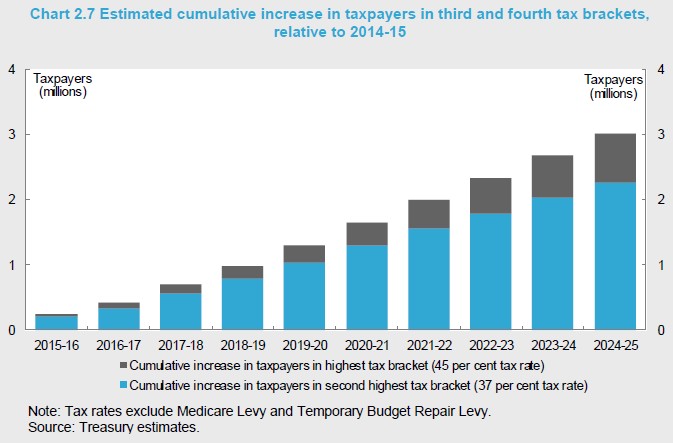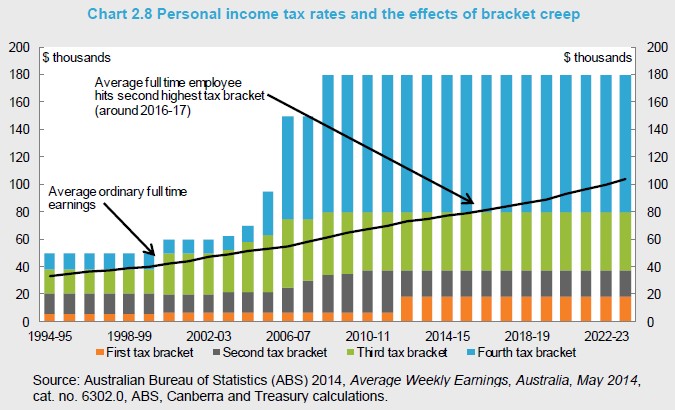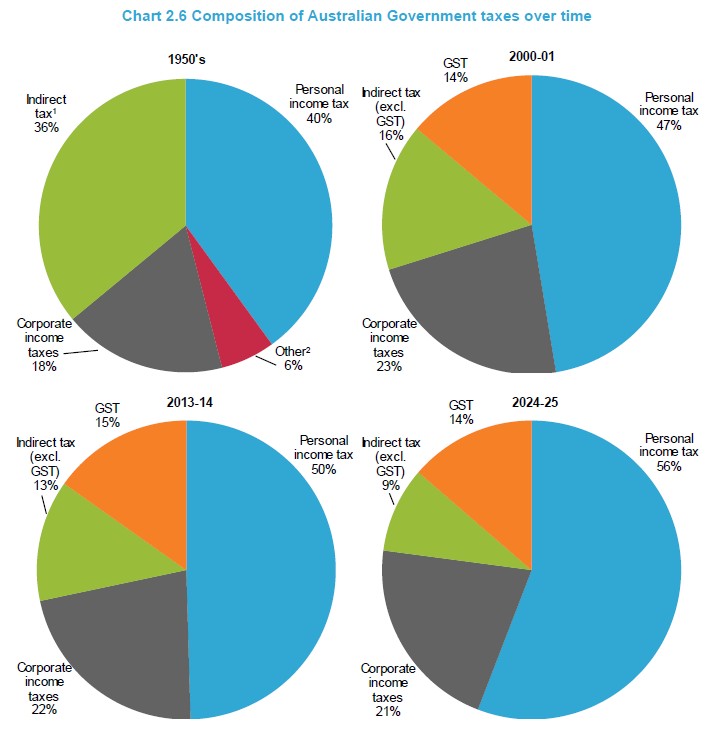“That’s three times the cost of broadening GST to food, health and education at $13.5 billion and just under the cost of broadening and raising the GST to 15 per cent at $53 billion,” [PwC managing partner Tom Seymour] said.
“The reality is, not reforming the tax system will hurt more people than some of the proposed changes”…
He said everything needed to be looked at: “Income taxes and bracket creep, business taxes, state taxes, the GST, negative gearing, the capital gains tax discount, superannuation concessions and base erosion and profit shifting must be part of the discussion. If they have already been ruled out, then we firmly believe they can and should be ruled back in.”
PwC’s research follows similar analysis from Australian Treasury’s recent tax discussion paper, which forecast that Australia’s reliance on inefficient personal income taxes will rise inexorably over the next decade (to 56% of taxes by 2024-25), making reform an imperative as the population ages and the share of workers across the economy declines:
Between 2014-15 and 2024-25, the percentage of taxpayers in the top two tax brackets (that is, with taxable income in excess of $80,000) is estimated to increase from around 27 per cent to 43 per cent under current policy settings. It is estimated that over 2 million more taxpayers will be in the third income tax bracket (taxable income from $80,000 to $180,000) in 2024-25, compared to 2014-15. There is also estimated to be around 750,000 more taxpayers in the fourth tax bracket (taxable income above $180,000) in 2024-25 compared to 2014-15 (Chart 2.7).

Treasury also noted that this bracket creep is highly regressive and inefficient:
…average ordinary full-time earnings were around $75,000 in 2013-14, and are expected to be around $104,000 in 2023-24 (see Chart 2.8). Someone on average full-time earnings therefore had an average tax rate of 22.7 per cent in 2013-14, increasing to 27.4 per cent by 2023-24. By contrast, someone with only half that income earned $37,500 in 2013-14, increasing to $52,000 in 2023-24. However, their average tax rate will increase from 10.3 per cent to 17.8 per cent. Someone earning twice the average full-time wage is on $150,000, increasing to $208,000 in 2023-24, but their average tax rate will only increase from 30.5 per cent to 34.3 per cent.
For some people, particularly those on relatively low incomes, bracket creep can reduce incentives to work. At higher incomes, bracket creep increases the incentives for tax planning and structuring, and even overseas relocation. Bracket creep is therefore not just an issue because of its effect on progressivity, but because over time it exacerbates the other problems in the individuals income tax system.

As I have argued frequently, the most obvious path to fiscal repair is to first reform Australia’s world-beating tax concessions (e.g.superannuation, negative gearing and the capital gains tax discount), which cost the Budget many billions of dollars in foregone revenue and are skewed towards the wealthy and higher income earners. Fundamental reform in these areas would also dramatically improve the progressiveness of the tax system and would counter concerns that budgetary reform is unfair and is placing the burden of adjustment unfairly on lower income households.
Second, Australia must look to broaden the tax base so that it is built around more efficient and equitable sources. This requires a shift in sources from productive effort (e.g labour and corporations) towards taxes on land, resources, and consumption, along with adequate compensation for the poor (in the case of raising/broadening the GST). Under this approach, the overall tax take could be raised at less economic cost than via bracket creep. The tax burden would also be shared more evenly across the population, rather than relying on a diminishing pool of workers to shoulder the load.
Unfortunately, by ruling-out reforms to Australia’s tax concessions – such as superannuation, negative gearing, and the capital gains tax discount – the Abbott Government seems intent to let the Budget deficit blow-out and the tax burden on younger working Australians to rise inexorably.
Another lost opportunity….


